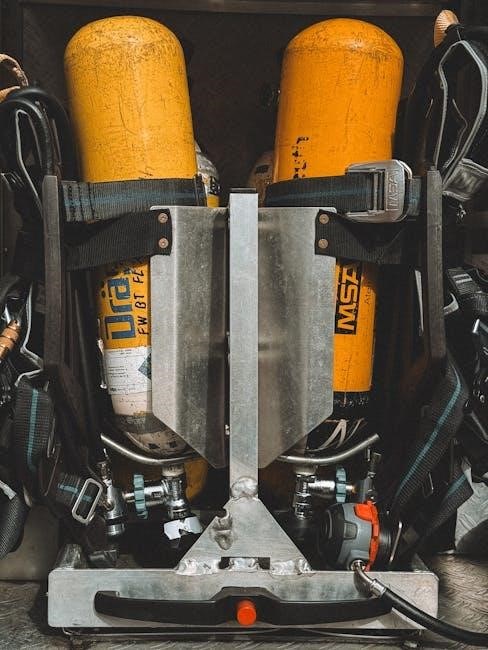
cld210m differential cylinder pressure tester manual
The CLD210M Differential Cylinder Pressure Tester is a diagnostic tool designed to help mechanics and technicians identify engine issues such as worn piston rings‚ faulty valves‚ and leaking head gaskets․ It provides accurate pressure readings to troubleshoot engine performance efficiently․

Key Features of the CLD210M Differential Cylinder Pressure Tester

The CLD210M is a versatile diagnostic tool offering advanced pressure testing capabilities․ It features a durable design‚ user-friendly interface‚ and precise measurement technology‚ making it ideal for identifying engine issues efficiently and accurately․
2․1 Technical Specifications
The CLD210M Differential Cylinder Pressure Tester is equipped with a wide range of technical features that ensure precise and reliable performance․ It operates within a pressure range of 0 to 30 psi‚ providing accurate measurements with a high degree of sensitivity․ The device is designed to be compatible with most modern engines‚ including gasoline and diesel variants‚ making it a versatile tool for various diagnostic needs․
The tester features a rugged‚ lightweight design with a durable casing to withstand the demands of frequent use in automotive workshops․ It is powered by a rechargeable battery‚ offering extended operating time and reducing the need for constant power supply․ The large‚ backlit LCD display ensures clear visibility of test results‚ even in low-light conditions․
Additional features include a built-in pressure sensor for quick and accurate readings‚ as well as a USB connectivity option for data export and analysis․ The device is supplied with a complete set of hoses and adapters‚ ensuring compatibility with a wide range of engines and cylinder configurations․ These technical specifications make the CLD210M an essential tool for mechanics and technicians seeking to diagnose engine issues efficiently and effectively․
2․2 Design and Build Quality
The CLD210M Differential Cylinder Pressure Tester is crafted with a focus on durability and usability‚ ensuring it withstands the rigors of frequent use in professional automotive environments․ Its sturdy‚ lightweight design allows for easy portability‚ making it convenient for technicians to move between vehicles and workstations․
The device features a rugged‚ high-quality casing that protects internal components from accidental drops or bumps․ The ergonomic grip is designed for comfort‚ reducing fatigue during extended use․ Additionally‚ the large‚ backlit LCD display is encased in a protective cover to prevent scratches and damage․
The tester’s hoses and adapters are constructed from durable materials‚ ensuring long-term reliability and resistance to oil‚ fuel‚ and other chemicals commonly found in engine environments․ The compact layout of the device makes it easy to store in toolboxes or workshops‚ saving valuable space․
Overall‚ the CLD210M combines robust build quality with thoughtful design elements‚ ensuring it remains a reliable and practical tool for mechanics and technicians seeking to diagnose engine issues efficiently․ Its attention to detail in both form and function makes it a standout choice in the automotive diagnostic industry․
How the CLD210M Works
The CLD210M Differential Cylinder Pressure Tester operates by measuring pressure differences across engine cylinders to detect internal combustion issues․ It uses advanced technology to provide precise readings‚ helping technicians quickly identify problems like worn piston rings or faulty valves․ Its user-friendly design ensures efficient diagnostics․
3․1 Operating Principles
The CLD210M Differential Cylinder Pressure Tester operates by measuring the pressure differences between engine cylinders to diagnose internal combustion issues․ The device connects to the engine’s cylinders‚ creating a sealed environment to capture accurate pressure readings․ By comparing these readings across cylinders‚ technicians can identify irregularities such as uneven compression or leaks․ The tester uses a combination of mechanical and electronic components to ensure precise measurements․ Its design allows for quick connection and disconnection‚ making the diagnostic process efficient․ The pressure data is then analyzed to determine the root cause of engine problems‚ such as worn piston rings‚ faulty valves‚ or leaking head gaskets․ This method provides a clear and reliable way to assess engine health‚ enabling targeted repairs and minimizing downtime․ The CLD210M is a valuable tool for mechanics seeking to troubleshoot engine performance issues with accuracy and speed․
3․2 Pressure Measurement Technology
The CLD210M Differential Cylinder Pressure Tester employs advanced pressure measurement technology to deliver precise and reliable results․ It utilizes high-sensitivity sensors to detect even minor pressure fluctuations within engine cylinders․ These sensors are calibrated to provide accurate readings‚ ensuring that technicians can identify issues such as uneven compression‚ leaks‚ or faulty components․ The device incorporates a digital display for clear visualization of pressure data‚ allowing for quick and efficient diagnostics․ The technology also features a self-compensating mechanism to account for external factors like temperature and humidity‚ ensuring consistent accuracy․ By measuring pressure differences between cylinders‚ the CLD210M helps pinpoint the exact source of engine problems‚ such as worn piston rings or leaking head gaskets․ This advanced technology enables mechanics to perform diagnostics with confidence‚ reducing guesswork and saving time․ The CLD210M’s pressure measurement system is designed to be both durable and user-friendly‚ making it an essential tool for professional engine diagnostics․

Step-by-Step Guide to Using the CLD210M
Connect the CLD210M to the engine’s cylinders‚ ensuring proper sealing․ Turn on the device and allow it to calibrate․ Conduct the test by activating the pressure measurement function․ Record and compare results across cylinders to identify discrepancies and diagnose issues accurately․
4․1 Pre-Test Checks and Preparation
Before using the CLD210M Differential Cylinder Pressure Tester‚ ensure the engine is cool to avoid damage or inaccurate readings․ Gather all necessary tools‚ including the tester‚ adapters‚ and the vehicle’s service manual․ Inspect the device for any damage or wear․ Calibrate the tester according to the manufacturer’s instructions to ensure accuracy․ Verify that all connections are secure and free from leaks․
Review the manual to understand the specific requirements for your engine type․ Disconnect the ignition and fuel systems to prevent accidental startups․ Use the appropriate adapters to match the engine’s cylinder configuration․ Double-check that the device is set to the correct pressure range for your vehicle․
Finally‚ ensure the environment is safe‚ with no open flames or sparks nearby․ Record the vehicle’s make‚ model‚ and engine specifications for reference․ By following these steps‚ you can ensure a safe and accurate testing process with the CLD210M․
4․2 Conducting the Pressure Test
To begin the pressure test with the CLD210M Differential Cylinder Pressure Tester‚ ensure the engine is in a cool state and all pre-test preparations are complete․ Start by inserting the testing hose into the first cylinder’s spark plug hole‚ ensuring a tight seal to avoid leaks․ Turn on the device and allow it to stabilize before recording the pressure reading․
Compare the reading with the manufacturer’s specifications or the readings from other cylinders to identify discrepancies․ If a cylinder shows significantly lower pressure‚ it may indicate issues like a cracked head or excessive wear․ Similarly‚ higher-than-normal pressure could suggest carbon buildup or other blockages․
After testing all cylinders‚ analyze the results to pinpoint the source of engine problems․ If you detect leaks‚ inspect the gaskets‚ piston rings‚ or valves for damage․ Always refer to the device’s manual for specific guidance on interpreting data and addressing potential issues․
Once the test is complete‚ carefully remove the testing hose and reconnect any components you disconnected․ Ensure the engine is safe to restart before proceeding with further diagnostics or repairs․

By following these steps‚ you can efficiently identify engine problems using the CLD210M and take the necessary steps to resolve them․